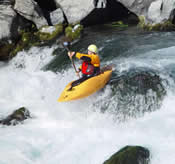|
Since this website debuted, there have been several changes
with kayaks. First is the number of kayaks suitable
for self-support. Though most creek and river running
kayaks of yesteryear had ample room for self-support
gear, not all had good access to that space. Some were
damned near impossible to load properly. The opening
between the seat and bottom of the cockpit rim was short
enough that long skinny drybags, or series of smaller
bags had to be used to get the gear in. This resulted
in the gear being strung out along the entire length
of the stern rather than being concentrated near the
seat where it would have the least effect on the boats
handling. That said, nearly all the creek and river
running boats of today have plenty of access space.
Secondly, the once highly regarded
European boats, that were the favorites of many self-supporters
due to their lack of stern pillars, ease of loading,
and reknowned durability are either gone or not readily
available. Sadly, Eskimo kayaks went out of business
several years ago and Prijon doesn't have the retail
presence it once did in the U.S. That said,
International Kayak Supply is the new U.S. Prijon
distributor and is working on better availability for
what looks like some fantastic designs.
Lastly, being that self-supporting
the Grand Canyon has gained popularity, there's now
a new breed of kayak available being called "crossover
designs". Their long length, retractable skegs,
and stern hatches make them especially suitable for
extended trips containing long stretches of flat water
between rapids. The cool folks at Liquid Logic kayaks
have had a number of successful 12 day Grand Canyon
trips in their crossover boats. Pyranha and Jackson
also have crossover designs.
Practicing
w/ fully loaded Riot Disco.  |
Though
it makes no sense to use a play boat for self-support,
it can be done with the gear & techniques talked
about here...if the run is favorable & the paddler
so inclined. I did it once, on a "class 4-5"
run...due in equal parts of meeting a challenge
& being silly. It went fine but I haven't had
the desire to repeat it. The message here, besides,
"don't be a dope", is that the age old
notion of needing a huge boat to fit the needed
camping kit is not true. As long as you & your
gear fall within the recommended weight range, there's
plenty of room in today's river runners & creek
boats for the typical trip. |
Boat Modifications
Even though most kayaks now days
are easy enough to load and unload, some paddlers are
still tempted to modify the seat and/or stern pillar....or
remove the pillar altogether. However, good seat modifications
are very time consuming and will void any warranty....
and, if done without structural engineering knowledge,
may make the boat unsafe. I do not
recommend it. Removing the
rear pillar entirely, or cutting it in half is even
worse. Do not perform either! Doing
so is a surefire way of weakening the kayaks structural
integrity.
°
kayak mods
General
tips
- If in the market
for a new boat, and you're concerned with its ability
to perform well while loaded, demo with your gear
packed in. Depending on the weight of the paddler,
and the particular boat, some kayaks will handle the
added weight of camping gear better than others. If
you can't demo, pay close attention to the manufacturers
recommended weight ranges and take in to account the
extra weight your gear will add.
If you're towards the upper end of the weight range,
the boat may take on a number of undesireable handling
traits when loaded with gear.
- Self-adhesive velcro placed inside
the boat can be used to contain smaller miscellaneous
items such as a map case. Place the "hook"
half on the boats plastic and the "loop"
half on the item you want to carry. Just be aware
that these things stand a chance of being lost during
a swim. Properly done though, the velcro will hold
lighter weight items just fine while paddling and
rolling.
- ALWAYS take materials to repair
a cracked boat. Click here
for further info.
|